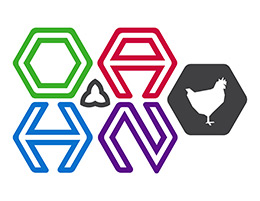Ontario Animal Health Network (OAHN)
Poultry Expert Network
Quarterly Producer Report
Risky business: Know your bird source before populating, backfilling or spiking your flock
Dr. Emily Martin (AHL) and Dr. Mike Petrik (Petrik Veterinary Consultants)
There are numerous examples of why mixing birds from different sources increases the risk of disease in a poultry flock. Ideally, all birds should be sourced from the same hatchery or growing facility. Source flocks develop their own unique sub-strains of certain diseases and are equipped to deal with different levels of insult without showing symptoms. Acquiring birds of different ages or from different sources increases the risk that a clinically healthy (subclinically infected) source flock may transmit disease to the birds they are mixed with. This could inadvertently result in disease distribution to multiple barns or farms creating the potential for an outbreak situation. Be cautious when spiking breeder flocks, or backfilling layer facilities. If the number of birds is a small percentage of the entire flock, it may be worth considering if the risk is worth the reward.
Avian metapneumovirus: Cases on the rise in multiple US states
Dr. Emily Martin (AHL)
In recent months, multiple states throughout the USA have documented increased cases of avian metapneumovirus infection (aMPV) with subtypes A and B. While we have identified subtype C in wild birds, we have not yet identified this disease in commercial poultry flocks in Canada. Therefore, the poultry industry needs to be aware of this disease and the clinical presentations.
Avian metapneumovirus is in the family Pneumoviridae and genus Metapneumovirus. It is an enveloped, single-stranded negative-sense RNA and has 4 identified antigenic subtypes (A to D). Subtype A and B are identified in chickens and turkeys while subtype C is identified primarily in turkeys as well as ducks. Other birds at risk include pheasants, game birds, and guinea fowl. Clinically healthy wild birds are considered a reservoir for this organism (i.e. waterfowl, sparrows, swallows, pigeons, falcons etc.). Wild birds and game birds have been found to be seropositive.
Avian metapneumovirus infection results in respiratory and reproductive disorders. High density poultry populations tend to have higher incidence of disease. The organism is spread primarily through direct contact or fomites. The incubation period is 3-7 days and the disease spreads rapidly within and between flocks. An entire flock can become clinical within a day. The birds shed virus for only a few days and there is no latency or carrier state. However, there are species differences in the onset and development of lesions. Unfortunately, clinical signs and lesions are non-specific.
TURKEYS
Clinical disease caused by aMPV in turkeys has been called turkey rhinotracheitis (TRT) and avian pneumovirus infection of turkeys (APV).
Regardless of age, turkey morbidity ranges from 40 to 100% and mortality ranges from 0.4% to 50%. Clinical signs include snicking, rales, nasal discharge, foamy conjunctivitis, swollen infraorbital sinuses, submandibular edema, coughing, open mouth breathing, and head shaking. Severe disease can be identified in 3 to 12 week old turkeys. In breeders, uterine prolapse can be secondary to coughing. In layers there can be up to 70% drop in egg production (range10-40%) including increased poor shell quality and peritonitis. Recovery can take up to 3 weeks.
CHICKENS
Clinical disease caused by aMPV in chickens, guinea fowl and pheasants has been called Swollen Head Syndrome (SHS).
The disease is not as well defined in chickens and can be subclinical. Less than 4% of flock can be affected. Mortality is rarely >2%. Egg production in broiler breeder and egg quality in egg layers is affected. Clinical signs can include swelling of the periorbital and infraorbital sinuses, torticollis, disorientation, and opisthotonos.
DUCKS
Clinical signs can include respiratory symptoms (type C), decreased egg production (40-85%), and poor shell quality (i.e. soft, thin-shelled, cracked).
There is variable pathogenicity between strains. Uncomplicated aMPV infection can have mild clinical signs but secondary infection(s) can increase the severity of disease. The virus affects the function of the cilia of the respiratory and reproductive epithelial cells, increasing susceptibility to secondary infections. Uncomplicated infections can clear in 10-14 days. Secondary infections include bacteria (E. coli, ORT, Pasteurella spp., B. avium, R. anatipestifer), mycoplasma (MG), aspergillosis, and viruses (i.e. IBV) resulting in potential development of airsacculitis and pneumonia.
On postmortem examination the following lesions can be observed:
Turkeys: Mucoid exudates in turbinates and trachea. Catarrhal inflammation of the upper respiratory tract (i.e. rhinitis, laryngitis, tracheitis). Various reproductive tract abnormalities in mature birds (i.e. egg peritonitis, folded shell membranes, misshapen eggs). Secondary infections can result in lesions of airsacculitis, pericarditis, pneumonia, perihepatitis, and in severe cases subcutaneous exudate and osteomyelitis in cranial bones.
Chickens: Severe edema in the subcutaneous tissues of the head, neck and wattles. Variable swelling of the infraorbital sinuses.
When deciding on diagnostic testing, it is important to realize that this virus does not persist within birds. The virus is cleared quickly and may only be detectable for 6-7 days post infection, so by the time clinical signs are recognized, it may be undetectable by PCR testing. Combining PCR and ELISA testing will aid in diagnosing and tracking disease within and between flocks. Antibody titres may be detectable 7 days post infection. Recommended samples include nasal secretions and sinus or tracheal swabs of mildly affected birds to test for aMPV and secondary infections. Histopathology requires collection of fresh tissues, but lesions are not pathognomonic.
There is no treatment for uncomplicated aMPV infection. Suggested interventions include general recommendations for disease management including biosecurity (preventing exposure to wild birds or other infected poultry), disinfection, and dedicated barn clothing. Good barn management involves providing good ventilation, controlling temperature, not overcrowding, maintaining litter quality, and not having multiage facilities.
Since this is an enveloped virus, it is sensitive to multiple disinfectants (i.e. quaternary ammonia, bleach, etc.) It is stable at pH 3.0 – 9.0 and inactivated at 56°C for 30 minutes. However, it has longer survival times (i.e. weeks) at lower temperatures and that could explain some seasonal occurrences.
Currently, AHL is working on updating their PCR testing to include detection of multiple subtypes of aMPV (currently detects type C). The ELISA available at the AHL can detect response to multiple subtypes of aMPV. If you have questions about this disease or diagnostic testing, we recommend producers contact their veterinarian while veterinarians can contact AHL.
References:
- Rautenschlein S. Avian Metapneumovirus. In: Swayne DE, ed. Diseases of Poultry, 14th ed., Vol I. Wiley Blackwell, 2020:135-143.
- Jones RC, Rautenschlein S. Avian Metapneumovirus. In: Swayne DE, ed. Diseases of Poultry, 13th ed., Wiley Blackwell, 2013:112-119.
- Kaboudi K, Lachheb J. Avian metapneumovirus infection in turkeys: a review on turkey rhinotracheitis. J Appl Poult Res 2021:30:100211. https://doi.org/10.1016/j.japr.2021.100211.
- https://ictv.global/taxonomy
Poultry Veterinarian Survey Highlights – Q1 2024 (Dec 2023 – Feb 2024)
Broilers
Early systemic bacterial infection (<14 d old) – ESBI
AHL: The number of cases were increased from the previous quarter. All cases had at least E. coli isolated either in pure culture or in combination with E. cecorum.
Practitioners: Practitioners indicated a commonly seen condition with stable to equally increased and decreased cases this quarter. Cases were attributed to Escherichia coli and Enterococcus cecorum.
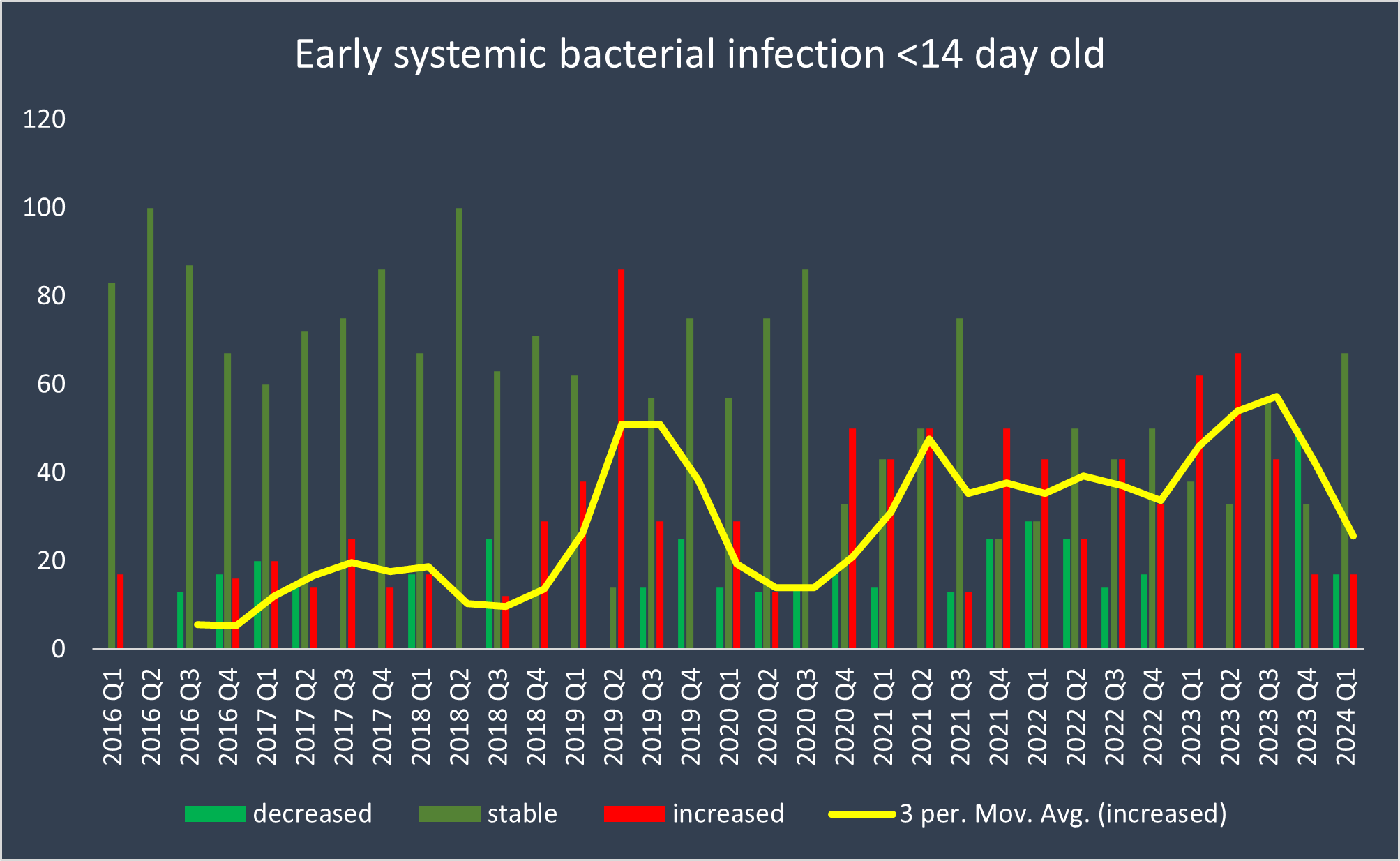
Other causes of early mortality (>14 d old) – OCEM
AHL: Two cases of early mortality due to mycotic pneumonia and dehydration (urate nephrosis) were identified this quarter.
Practitioners: Stable this quarter with spiking mortality syndrome and IBH as main causes. Veterinarians are describing OCEM as rarely identified in the broiler flocks.
Late systemic bacterial infection (>14 d old) – LSBI
AHL: The number of cases were increased from the previous quarter to reach similar numbers to Q3 2023. All cases had at least E. coli isolated either in pure culture or in combination with E. cecorum, Salmonella Kentucky, or E. cecorum and S. aureus.
Practitioners: Practitioners reported stable to increased numbers of infections with E. coli and E. cecorum listed as the main bacteria identified. LSBI was described as a common condition seen in the broilers. Also, practitioners reported that between December 2023 and February 2024, 15-40 % of E. coli isolates were identified to be resistant to Trimethoprim sulfa (TMS).
Lameness – viral
AHL: The confirmed reovirus pathology cases were similar in number to the previous 2 quarters. There were an increased variety of strains from the previous quarter that included SK_R12, PA genotype 6-03200-2012, ON_variant_A_12-073195, ON_variant_B_12-070460, and Pennsylvania 13-095523. Reovirus suspicious cases (identified on histopathology) were similar in number to the previous quarter.
Practitioners: Cases were reported as stable to slightly decreased with the frequency identified as mostly rare in the broiler flocks this quarter.
Lameness – bacterial
AHL: The number of cases continued to decrease compared to the previous 3 quarters. These cases were primarily diagnosed on histology.
Practitioners: Reported as stable to increased for this quarter with cases attributed to E. cecorum and E.coli bacteria. This type of lameness was common to rarely identified condition in the flocks.
Lameness – developmental
AHL: The number of cases were increased from the previous 2 quarters with 7 cases of tibial dyschondroplasia identified on histology.
Practitioners: Stable to slightly increased cases with mostly rare to less common frequency or not seen this quarter.
Lameness – nutritional
AHL: The number of nutritional causes of lameness were the same as the previous quarter (1 case of rickets).
Practitioners: Respondents reported stable to slightly increased incidences of nutritional lameness with rare frequency or not seen in the flocks.
Ascites
AHL: No cases of ascites were diagnosed in diagnostic cases this quarter.
Practitioners: Reported as stable to slightly increased with equal number of respondents reporting rare to common frequency detection.
Coccidiosis and necrotic enteritis
AHL: The cases of both coccidiosis and necrotic enteritis were decreased from the previous 4 quarters. The majority of coccidiosis cases were identified in the small intestines while 1 was identified in the ceca.
Practitioners: Cases of coccidiosis and necrotic enteritis were reported as stable for this quarter with equal number of respondents reporting rare to common frequency detection.
Inclusion body hepatitis (IBH)
AHL: Cases identified either on histology or as PCR positive were increased from the previous quarter. On Fowl adenovirus PCR, the most common species was FAdVE, either on its own or in combination with FAdVD or FAdVAC. As in previous quarters, on sequencing the primary strain identified was FAdV08b (i.e., FAdV08b_AHL_16-049095_ON and FAdV08b_AHL_18-057921_ON). Sequencing also identified FAdV11_USA_1047.
Practitioners: Reported increased to stable cases with one respondent noticing decreased detection in cases this quarter. This condition was commonly observed in the broiler flocks and was described affecting chickens at 3-4 weeks of age but with lower-than-expected percentage of mortality (3%).
Infectious bursal disease
AHL: The number of pathology cases was increased compared to the previous 2 quarters while PCR positive numbers were comparable to Q3 2023. On sequencing the primary field strain identified was USA PA105-2014. Other field strains included USA 66-Indiana-2014, British Columbia 15-062782, and ON_NC171-06-48866. The vaccine strains included USA W2512-Blen, and UK Faragher 52-70.
Practitioners: Reported stable cases with many respondents identifying this condition as rare during this quarter.
Infectious bronchitis (IBV)
AHL: The number of pathology cases were increased from the previous 2 quarters but the number of PCR positive samples were increased from the previous 4 quarters. The primary strain identified was IBV_DMV_ON_21-017385 and the vaccine strains identified were IBV_Conn, USA Mass-AHL 21-008165, and IBV_Mass-MA5.
Practitioners: IBV detection was reported increased to stable by respondents and was identified as a common condition in the broiler flocks. The disease is mostly detected in the flocks close to reaching market weight and secondary bacterial infections complicate the cases leading to increased condemnations at slaughter.
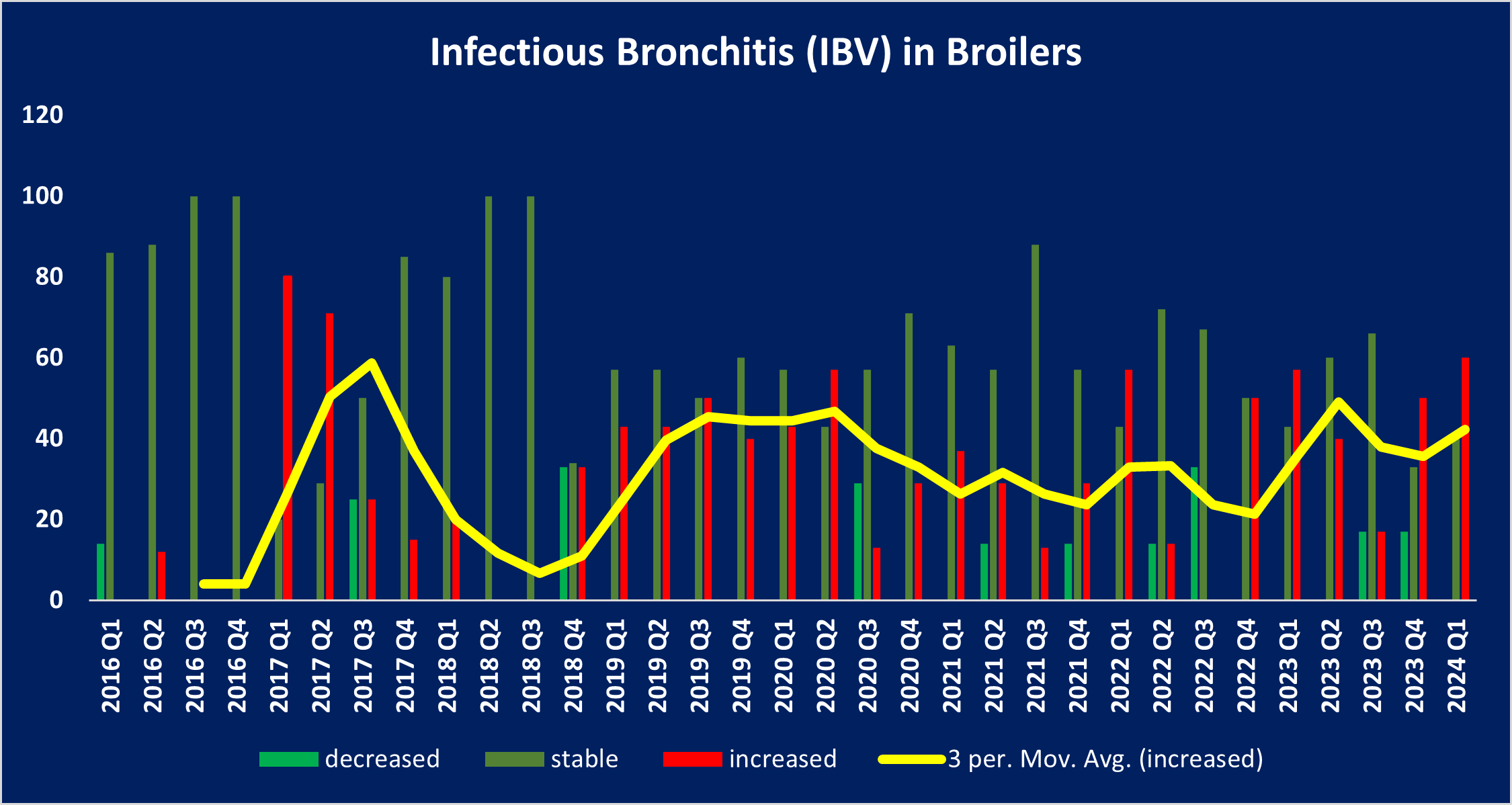
Spiking mortality
AHL: No cases of spiking mortality were diagnosed on histology this quarter.
Practitioners: Reported as stable for this quarter. This condition was described as rarely encountered to not seen in the flocks by practitioners.
Salmonella
Practitioners: Salmonella isolations were reported as stable this quarter. The frequency of this condition is equally described as rare detection or not seen in the flocks by respondents. The most common serotypes isolated were serotypes B and D, with subtypes of S. Enteritidis, S. Kentucky and S. Alachua (graph below). Practitioners also list S. Typhimurium and S. Enteritidis.
Animal Health Laboratory Salmonella Isolations: Broilers

Runting and Stunting Syndrome (RSS)
AHL: Confirmed and suspect cases of RSS (diagnosed on histology) were increased compared to the previous 2 quarters reaching similar numbers to Q2 2023.
Practitioners: RSS cases were reported as stable. The frequency of this condition was described as rare. However, there were equal number of practitioners describing as a common condition to not seen in the broiler flocks.
Other diagnostic findings
AHL: Other diagnoses made at the AHL included bile duct hyperplasia, hepatic lipidosis, mycotic airsacculitis, E. coli enteritis, heterophilic typhlitis, proventriculitis, proventricular glandular dilation, ventriculitis, gangrenous dermatitis (E. coli, C. septicum) and bacterial pneumonia.
Practitioners: Few cases of dilated proventriculus with lesions seen monthly by practitioners this quarter.
Dead on arrival (DOA)
AHL: There were multiple DOA cases examined this quarter having numerous diagnoses including ascites, fractured liver with hemorrhage, bone fracture/dislocation, E. coli septicemia, septicemia (E. coli, S. aureus), deep pectoral myopathy, cecal coccidiosis, and IBV.
Condemnation issues
AHL: No condemnation cases submitted in this quarter.
Practitioners: Issues were reported as stable to increased conditions for this quarter. Cellulitis was the most common cause of condemnations.
Provincial slaughter plants:
The top carcass post mortem condemnation conditions reported for December 2023 to February 2024 were ascites, airsacculitis, and cellulitis.
Comparison of provincial condemnation conditions: Dec 2022-Feb 2023 vs Dec 2023-Feb 2024
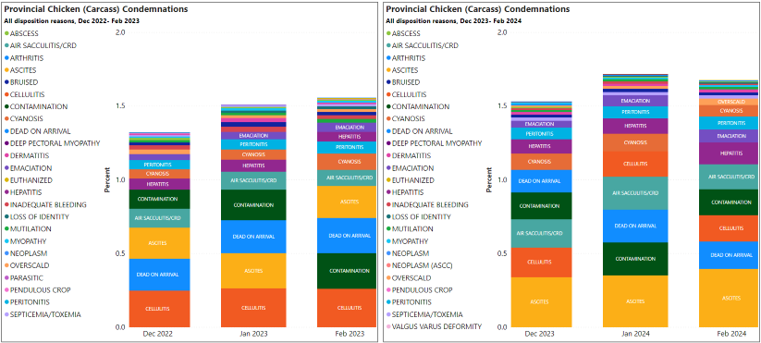
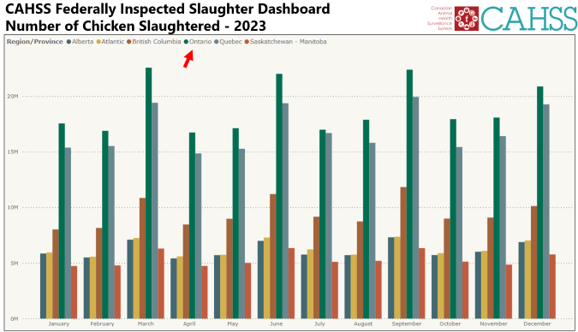
Subcutaneous conditions, liver conditions, and abdominal oedema were reported as the main conditions for condemnation for chickens slaughtered in federally inspected plants in Ontario in 2023 (graph below).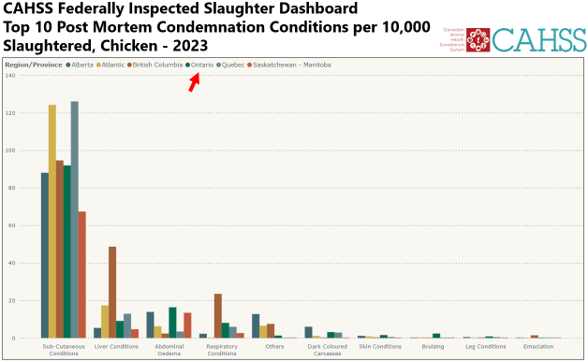
Broiler-Breeders
Fowl cholera (Pasteurella multocida)
AHL: Occasionally isolated from lameness cases from vaccinated flocks. One case in a prelay aged flock.
Practitioners: Reported stable this quarter in vaccinated flocks with high culling rate and low mortality specifically affecting male birds. This is mostly a long-standing, low-grade form of P. multocida infection. It was noted that the affected flock is responding well to antibiotic treatment based on susceptibility testing. Respondents stated that frequency of cases is rare or never been seen in the flocks.
Early bacterial infection (<14 d old)
AHL: The number of cases increased slightly from last quarter. Cases had either E. coli isolated in pure culture or in combination with E. cecorum.
Practitioners: Reported as stable to slightly decreased with common frequency and E. coli identified with the isolates.
Other causes of early mortality (<14 d old)
AHL: There was 1 case of dehydration/urate nephrosis and 1 case of excessive beak trimming identified.
Practitioners: Reported as stable to slightly decreased with rare frequency or not identified this quarter.
Prelay morbidity/mortality (<20 weeks)
AHL: The case numbers were increased from the previous 2 quarters to similar numbers compared to Q2 2023. Cases of septicemia had a wide variety of bacteria and bacterial combinations identified. These included, S. aureus isolated in pure culture or combined with E. coli, or E. coli and E. cecorum with or without G. anatis. E. coli and E. cecorum were also isolated together or in combination with G. anatis. One case isolated P. multocida alone (see Fowl Cholera above). Other diagnoses included emaciation, intussusception and CAV.
Lameness – bacterial
AHL: The case numbers were similar to the previous quarter. S. aureus was isolated in pure culture or in combination with E. coli, E. cecorum, P. aeruginosa, Avibacterium spp., and P. multocida. E. coli and E. cecorum were also isolated together or in combination with S. aureus and G. anatis. Other bacterial combinations included S. aureus/E. coli/S. agnetis and S. aureus/E.cecorum/C. perfringens. Pure culture of P. aeruginosa was also identified. Cases of osteomyelitis had either S. aureus isolated in pure culture or a mixed culture of E. coli/E. cecorum/G. anatis. One case of pododermatitis was identified on postmortem/histology (decreased from the previous 2 quarters).
Practitioners: Reported as stable to slightly increased cases with common frequency seen in the flocks. This quarter, observing more mixed infections with E. coli, E. cecorum, Staphylococcus aureus and Pasteurella multocida.
Lameness – viral, developmental and nutritional
AHL: Only one case of reovirus (PCR positive) identified this quarter. Two cases of rickets were also diagnosed on histology.
Practitioners: All conditions reported as stable by responders with rare frequency or not seen during this quarter.
Inlay bacterial septicemia
AHL: The number of cases were decreased compared to the previous quarter but similar in number to Q3 2023. The majority of cases had E. coli isolated in combination with E. cecorum, S. aureus, or P. multocida. E. coli and E. cecorum were isolated together along with P. aeruginosa, Avibacterium spp., C. perfingens, S. aureus, or G. anatis and S. aureus. Other bacteria identified in pure culture included S. aureus.
Practitioners: Septicemia was reported as stable to slightly decreased this quarter with equal number of respondents reporting as rare or common condition encountered in the flocks. E. coli is listed as a cause.
IBV – decreased production/ abnormal eggs
AHL: No cases with these clinical signs diagnosed in this quarter.
Practitioners: Reported stable to slightly decreased cases with equal number of practitioners stating that this condition is rare or common or not seen in the field this quarter.
IBV – sudden spike in mortality
AHL: The pathology case numbers were similar to the previous 3 quarters; however, PCR positive cases were decreased from the previous quarter. Strains identified included IBV_DMV_ON_21-017385, IBV_Mass-H120 vaccine, IBV_Mass-MA5 vaccine, and IBV_USA_Mass_AHL21-008165-001 vaccine.
Practitioners: Respondents were reporting stable to slightly decreased cases with most of respondents describing as rare condition or not seen in the broiler breeder flocks.
Disease related hatchability issues
Practitioners: Reported as stable condition with one respondent reporting increase in cases for this quarter. The majority of respondents stated that this condition was not seen in the flocks or was identified with rare frequency.
Mycoplasmosis
AHL: One case of M. synoviae diagnosed this quarter.
Practitioners: Stable condition with one respondent reporting cases associated with M. synoviae from a point source of introduction that spread to multiple farms. This condition was not seen in the flocks by most of the respondents.
Necrotic enteritis
AHL: No cases diagnosed this quarter.
Practitioners: The number of necrotic enteritis cases were reported as stable. Equal number of respondents were stating that frequency of this condition was rare or not seen in the flocks.
Coccidiosis
AHL: The cases were increased from the previous 4 quarters. Coccidia were identified in the small intestines, ceca, or both the small intestines and ceca.
Practitioners: Stable number of cases reported. As for frequency, this condition was seen equally as common or rare or not seen in the flocks by respondents.
Fowl pox and ILT
AHL: No cases of fowl pox or ILT diagnosed this quarter.
Practitioners: Both conditions reported as stable for this quarter.
Salmonellosis (clinical)/Salmonella isolation
Practitioners: Stable with a variety of Salmonella isolates including S. Livingstone, S. Agona, and S. Kentucky. Origin listed as detection from environmental samples.
Animal Health Laboratory Salmonella Isolations: Broiler Breeders
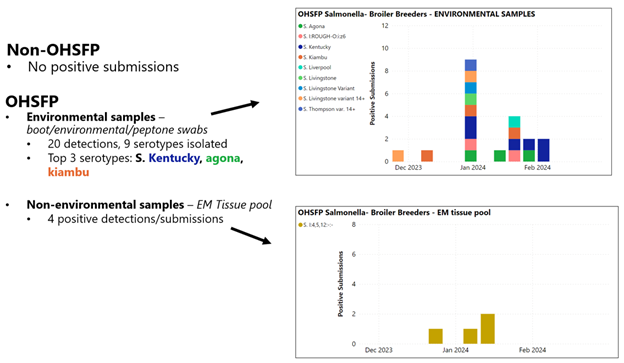
Aggression and cannibalism
AHL: One case of cannibalism diagnosed this quarter.
Practitioners: Cases were reported as stable with one respondent reporting continuing increase in cases (more male to male feather licking) compared with the last quarter. This condition was described as rare in frequency to never or not seen in the flocks.
Multi-drug resistant E. coli (resistant to >3 drugs)
Practitioners: Reported as stable with equal number of respondents describing as rare to not detected in the flocks.
Histomoniasis (blackhead)
AHL: Four cases of histomoniasis, 2 cases with Heterakis, and 3 cases with Ascarids identified this quarter.
Practitioners: Stable cases reported by respondents. This condition was described mostly not seen or with rare frequency detection in the flocks.
White Chick Syndrome
AHL: Two cases diagnosed this quarter.
Practitioners: Cases listed as occurring in this quarter.
Other
AHL: Other diagnoses this quarter included gangrenous dermatitis (1 – E. coli/E. cecorum, 1 – C. perfringens/S. aureus), salpingitis (E. coli), neoplasia (adenocarcinoma), liver hemorrhage, internal hemorrhage, hydropericardium, tendon rupture, fungal pneumonia, amyloidosis, urate nephrosis/visceral urates and bacterial pneumonia (S. aureus, E. coli/E. cecorum with either S. aureus or G. anatis).
Practitioners: Five responders mentioned other cases as being stable to slightly increased. The most common condition seen was gangrenous dermatitis
Layers
The same as last quarter, veterinarians reported good, stable and solid health status for the past 3 months.
Osteoporosis
Practitioners reporting stable condition. The frequency of this condition was rare, and some respondents did not see it in the flocks this quarter.
Bacterial peritonitis/salpingitis
AHL: Two cases (1 peritonitis, 1 salpingitis) diagnosed this quarter.
Practitioners: Stable cases and the frequency of this condition remains rare to common state as with previous quarter.
Early systemic bacterial infection (<14 old) – ESBI
AHL: Increased cases from previous quarters. Two cases of starveouts and 1 case of omphalitis diagnosed this quarter.
Practitioners: Reported as stable and the frequency reported by practitioners was rare to not seen.
Other causes of early mortality (>14 d old)
AHL: Increased cases from previous quarters. Two cases of yolk sacculitis, 1 case of peritonitis, and 1 case of dehydration diagnosed this quarter.
Practitioners: Other causes of early mortalities were stable with equal numbers of responders reporting as rare to not seen in the flocks.
Prelay mortality (<20 weeks)
AHL: The number of cases were the same as the previous quarter with 1 case of mycotic pneumonia diagnosed.
In-lay mortality (>20 weeks)
AHL: The cases of in-lay mortality are decreased compared to the previous 2 quarters. Diagnoses included 2 cases of septicemia diagnosed on histology.
Focal duodenal necrosis (FDN)
AHL: One case diagnosed this quarter (diagnosis made on histopathology).
Practitioners: Responders were reporting stable cases. Equal numbers of responders were reporting the frequency of this condition as common, rare or not seen in the flocks this quarter.
IBV – production drop/abnormal eggs and respiratory issues
AHL: No pathology cases diagnosed this quarter. PCR positive cases that were sequenced identified strains that were primarily vaccine related (IBV_CA_1734_04_ON_12-025379, IBV_USA_Mass_AHL21-008165-001 vaccine, IBV_Mass-MA5 vaccine, IBV_Conn vaccine). A case of increased mortality identified cystic oviducts.
Practitioners: Stable cases reported by majority of respondents with one practitioner reporting increase in cases this quarter. Most of the respondents are reporting rare frequency or not seen for this condition. California strain of IB seems to be more aggressive compared with the past few years. It was noted increases in mortality (0.5-1% in total) for a couple of weeks and noticeable (10%) production drops in the affected flocks.
Salmonellosis (clinical) / Salmonella isolation
Practitioners: Reported as stable with one respondent seeing increased cases.
Animal Health Laboratory Salmonella Isolations:
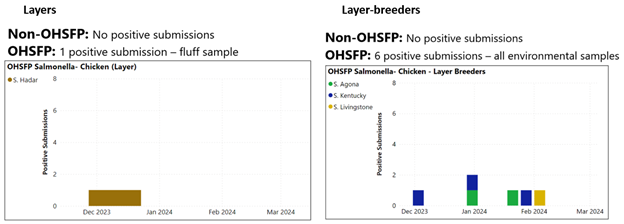
ILT and Mycoplasma
AHL: One case of ILT identified by PCR this quarter.
Practitioners: Stable for both conditions with the majority of respondents stating that both conditions were not seen in the layer flocks during this quarter.
Coccidiosis and necrotic enteritis
AHL: One case of small intestinal coccidiosis and no cases of necrotic enteritis diagnosed this quarter.
Practitioners: Reported stable for both conditions with rare frequency noted by the respondents. It was noted that the main cause of intussusception in pullets was coccidia infestation.
Aggression, cannibalism and hysteria
Practitioners: All reported as stable this quarter. The frequency of aggression and cannibalism condition was common to rarely seen in the layer flocks.
Multi-drug resistant E. coli (resistant to >3 drugs)
Practitioners: Stable condition that have not been seen by most of respondents or with rare frequency seen by few practitioners this quarter.
Histomoniasis (blackhead)
AHL: No cases diagnosed this quarter.
Practitioners: Stable condition that was not detected this quarter by any of the respondents.
Other
AHL: Other diagnoses were increased from the previous 2 quarters including emaciation, airsacculitis/tracheitis/sinusitis, enteritis (bacterial, heterophilic), ventricular erosion, ventriculitis, proventricular glandular dilation, fatty liver, internal lay, oophoritis, cage layer fatigue, and vaginal prolapse.
Practitioners: Starve out condition in pullets was mainly related to poor management during transportation from the hatchery or brooding phase. Also, two cases of otitis externa were diagnosed this quarter.
Turkeys
Fowl cholera (Pasteurella multocida)
AHL: No cases diagnosed this quarter.
Practitioners: Most of the responders reported this condition as stable with equal number of practitioners reporting increased and decreased cases. P. multocida along with E. cecorum and E. coli was detected in an 8-week-old female turkey meat flock. The frequency of this condition it is still described as not seen by most of the respondents.
Erysipelas
AHL: No cases diagnosed this quarter.
Practitioners: Was reported stable and this condition was not seen or was very rare this quarter.
Early systemic bacterial infection (<14 day old) – ESBI
AHL: No cases diagnosed this quarter.
Practitioners: Mainly stable condition with one practitioner reporting decreased cases. Streptococcus gallolyticus continues to be detected as the most common bacteria but not to the same extent as with the previous quarter. E. coli was the other bacteria identified. The frequency of this condition was mostly reported as rarely seen in the flocks.
Other causes of early mortality (<14 d old)
Practitioners: Like the previous quarter this condition was reported stable. Most of the responders reported the frequency of this condition as rare in turkey flocks but starveouts was listed as a cause.
Late systemic bacterial infection (>14 d old) – LSBI
AHL: The number of cases were decreased from the previous quarter. E. coli was isolated in pure culture or in combination with E. cecorum and Pasteurella multocida.
Practitioners: The majority of the responders reported as stable with one practitioner seeing a decrease in detection of this condition. E.coli was the main bacteria identified by multiple practitioners to be responsible for LSBI. The frequency of this condition was mainly rare with two respondents reporting as not seen and one respondent seen a as common in the flocks.
ORT
AHL: No cases diagnosed this quarter.
Practitioners: Stable condition with one respondent reporting increase in cases. Most respondents reported no detection of ORT or was seen with rare frequency in the flocks.
Mycotic and other respiratory disease
AHL: Increased cases from the previous quarter. Diagnoses included sinusitis/bacterial pneumonia (E. coli, E. cecorum, Pasteurella multocida), E. coli pneumonia, and fibrinoheterophilic pneumonia.
Practitioners: Reported as stable to slightly decreased this quarter. Responders were not identifying these conditions, or it was seen with rare frequency in the flocks.
Coccidiosis
AHL: No cases of coccidiosis diagnosed this quarter.
Practitioners: Stable cases with lesions located on duodenum, jejunum and cecal segments of the intestines. The frequency of the cases seen were reported as rare to not seen this quarter. One respondent noted some reactions to vaccination in the flocks.
Histomoniasis
AHL: One case of histomoniasis diagnosed this quarter.
Practitioners: The majority of the responders reported stable cases detected. Two responders noted decreased cases this quarter. As far as frequency, this condition was identified as not seen in the flocks.
Mycoplasma
AHL: One case of Mycoplasma gallisepticum diagnosed this quarter.
Practitioners: Stable to slightly decreased this quarter with rare frequency encountered in the flocks. The most common Mycoplasma species identified was M. gallisepticum.
Multi-drug resistant E. coli (resistant to >3 drugs)
Practitioners: Stable condition with frequency of the cases equally reported as rare to not seen by respondents.
Necrotic enteritis and enteritis
AHL: No cases of necrotic enteritis or enteritis diagnosed this quarter.
Practitioners: Both conditions were reported as stable, and the frequency was rare or not seen in the flocks during this quarter.
Reovirus tenosynovitis
AHL: No cases diagnosed on histology. There were a decreased number of PCR positive cases and no sequencing pursued.
Practitioners: Most of the respondents reported stable condition with one respondent reporting decreased cases this quarter. Two respondents reported viral tenosynovitis as commonly encountered, with the rest of the responders reporting as rare frequency condition.
Round heart
AHL: No cases of round heart identified this quarter.
Practitioners: Stable to slightly decreased condition this quarter. Respondents reported this condition as rarely encountered with two responders reporting not being seen in the turkey flocks.
Aggression and cannibalism
AHL and practitioners reported no cases detected and stable for this quarter. Equal number of respondents reported the frequency of condition as common or rare or not seen in the flocks.
Other
AHL: Other diagnoses included tibial dyschondroplasia, tenosynovitis (histology), bacterial osteomyelitis, pox, cellulitis/dermatitis/epidermal necrosis, myodegeneration/ myonecrosis, E. coli typhlitis, and endophthalmitis (fungi, bacteria). One condemnation case identified abscesses with heterophilic myositis.
Practitioners: Aortic rupture is detected more as part of the sudden death diagnosis. Also, one case of Fowl pox was detected in one flock.
Salmonellosis (clinical)/Salmonella isolation
Practitioners: Reported stable to slightly decreased. S. Brandenburg, S. Hadar and S. Newport were listed as the main isolates.
Animal Health Laboratory Salmonella Isolations: Turkey – Meat
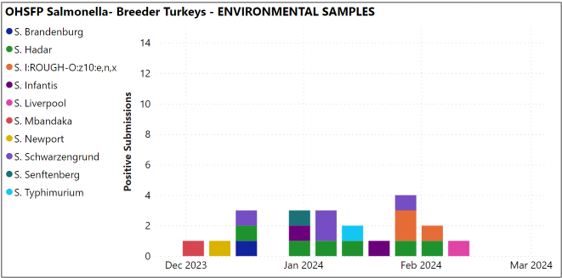
Animal Health Laboratory Salmonella Isolations: Turkey – Breeders

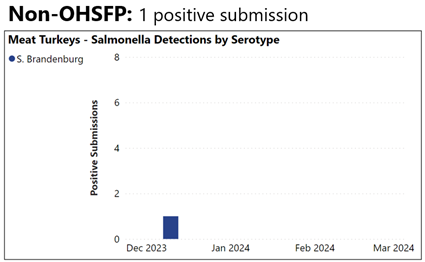
Turkeys continued …
Provincial slaughter plants:
The top carcass post mortem conditions reported for December 2023 to February 2024 were abscess, airsacculitis, and cellulitis.
Comparison of provincial condemnation conditions:
Dec 2022-Feb 2023 vs Dec 2023-Feb 2024
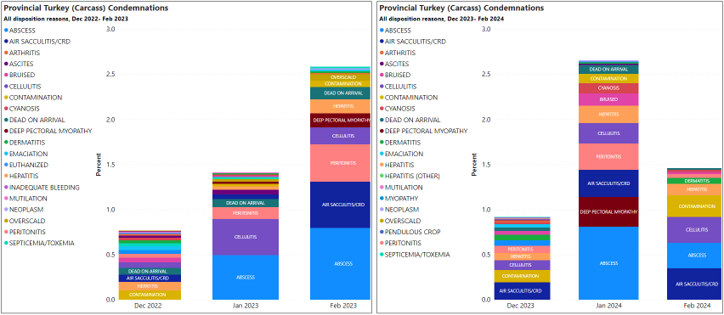
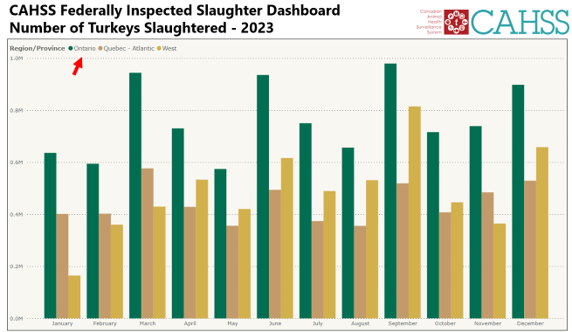
The top condemnation conditions for turkeys slaughtered in federal plants in Ontario in 2023 were subcutaneous conditions, other conditions, and emaciation (graph below).
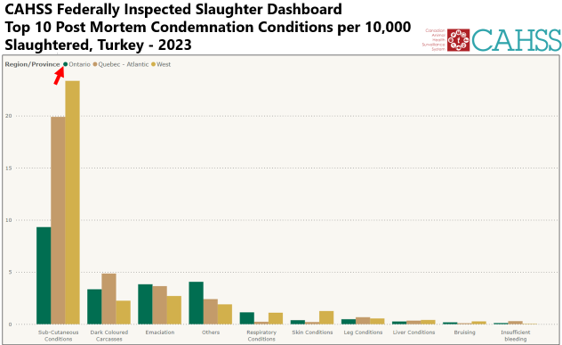
Small Flock
Chickens
AHL: Diagnoses at AHL included intestinal parasitism (coccidiosis, nematodiasis, cestodes), Marek’s disease, salpingitis, peritonitis, bacterial septicemia, sinusitis, ILT (4 PCR positive: 2 Niagara-like field strain CAGG cluster, 2 CEO/TCO vaccine-like strain TCAA cluster), cellulitis (base of neck), osteomyelitis, infectious coryza (A. paragallinarum), emaciation, welfare case (Mycotic conjuncitivitis, lice, MG, MS, Marek’s, nematodes, protozoa), and IBV.
Practitioners: Reporting all conditions stable but with different frequency seen in the field as follows:
- Common to very common: Ectoparasitism (lice, mites, scaly leg mites), endoparasitism and mycoplasma.
- Common: Peritonitis/salpingitis, bacterial septicemia, pneumonia/airsaculitis and other neoplasia.
- Rare to common: GI impaction, ascites, pododermatitis and trauma
- Rare: Urate nephrosis/visceral gout/articular urate deposits, and histomoniasis.
ILT: Four cases diagnosed in small flocks during this quarter.
Gamebird
AHL: Two peafowl cases submitted this quarter.
1.Emaciation, Parasitism (Trichuris, Ascarids)
2.Sinusitis (MG, Mycoplasma spp., 5 bacteria)
Practitioners: Gamebirds/ ratites: None of these species were reported to be physically examined during this quarter.
Duck
AHL: Five cases submitted this quarter.
1.Muscovy – Suspect reticuloendotheliosis
2.Muscovy – Urate nephrosis, Visceral/articular gout
3.Pekin – Oophoritis, salpingitis
4.Duck – Necrotizing bacterial dermatitis/cellulitis (S. aureus)
5.Duck – Myopathy (E. cecorum, E. coli)
Practitioners: No cases or flocks examined reported for this quarter.
Turkey
AHL: No cases submitted this quarter.
Practitioners: No information provided with the clinical impression this quarter.
Waterfowl
AHL: One swan with squamous cell carcinoma.
Practitioners: None reported.
Pigeons
AHL: Three cases submitted this quarter.
1) Lice, bacterial pneumonia (S. aureus, E. coli), nematodes (jejunum)
2) Bacterial hepatitis (E. coli)
3) Hemorrhage (ovarian follicle)
Practitioners reporting the following conditions as rarely encountered: Trichomoniasis (‘canker’), APMV-1, Salmonellosis, chlamydiosis, pox, fungal and traumatic conditions.
The most common conditions detected were intestinal and external parasitism, bacterial infection, and mycoplasma.
Poultry research from Ontario and beyond
Events and News
Poultry Industry Council events: https://www.poultryindustrycouncil.ca/events
Poultry Health Research Network information, events, and lectures can be accessed on the PHRN website: https://phrn.net/ or on the PHRN YouTube channel: https://www.youtube.com/user/PoultryHRN
Thank You!
We thank the following poultry veterinarians who completed the veterinary survey:
Dr. Elizabeth Black, Dr. Joanne Dias, Dr. Fernando Salgado-Bierman, Dr. Peter Gazdzinski, Dr. Shahbaz Haq, Dr. Elana Huong, Dr. Anastasia Novy, Dr. Mike Petrik, Dr. Erin Preiss, Dr. Joanne Rafuse, Dr. Ben Schlegel, Dr. Chanelle Taylor, Dr. Brenna Tuer, Dr. Alex Weisz, Dr. Jessalyn Walkey, and Small Flock Veterinarians.
